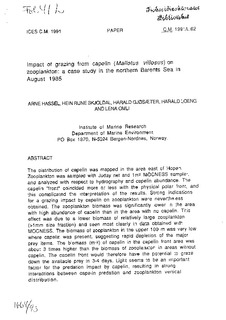Impact of grazin from capelin (Mallotus villosus) on zooplankton: a case study in the northern Barents Sea in August 1985
Working paper
Permanent lenke
http://hdl.handle.net/11250/104932Utgivelsesdato
1991Metadata
Vis full innførselSamlinger
Originalversjon
This report is not to be cited without prior reference to the authorsSammendrag
The distribution of capelin was mapped in the area east of Hopen.
Zooplankton was sampled with Juday net and 1m^2 MOCNESS sampler,
and analyzed with respect to hydrography and capelin abundance. The
capelin "front" coincided more or less with the physical polar front, and
this complicated the interpretation of the results. Strong indications
for a grazing impact by capelin on zooplankton were nevertheless
obtained. The zooplankton biomass was significantly lower in the area
with high abundance of capelin than in the area with no capelin. This
effect was due to a lower biomass of relatively large zooplankton
(>1 mm size fraction) and seen most clearly in data obtained with
MOCNESS. The biomass of zooplankton in the upper 100 m was very low
where capelin was present, suggesting rapid depletion of the major
prey items. The biomass (m^2) of capelin in the capelin front area was
about 3 times higher than the biomass of zooplankton in areas without
capelin. The capelin front would therefore have the potential to graze
down the available prey in 3-4 days. Light seems to be an important
factor for the predation impact by capelin, resulting in strong
interactions between capelin predation and zooplankton vertical
distribution.
